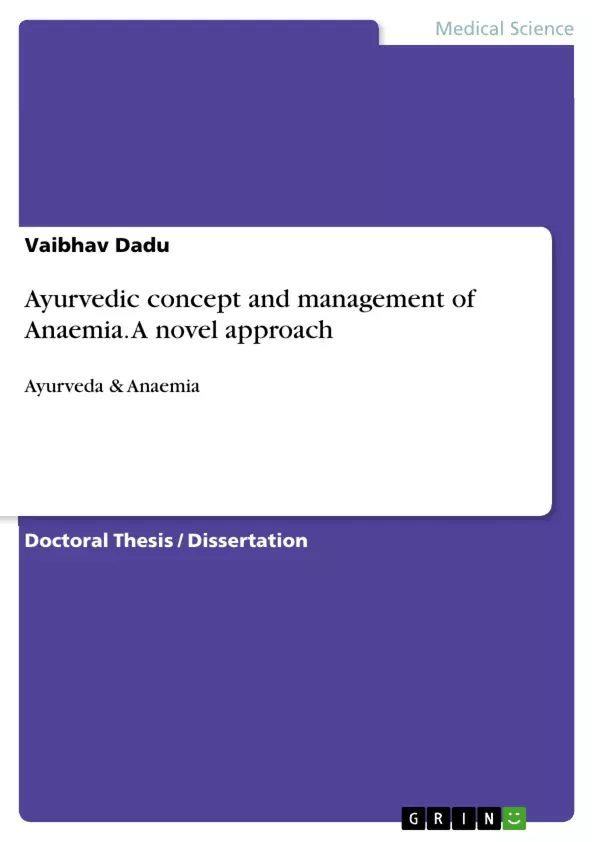The Ayurveda is the holistic system of medicine successfully thriving since time immemorial owing to its strong foundation in the form of the basic principles which have not undergone any alteration since their inception. The Ayurveda classics mainly the Charaka and Sushruta Samhita (treatises) are a treasure of knowledge in a code form. These classics need to be reviewed in the new and contemporary scientific background to re validate their strength.
The disease Anaemia is a very common ailment widely prevalent in India and the developing world. Ayurveda mentions Anaemia in the form of the depleted blood tissue (rakta dhatu in Ayurveda parlance) . The science of Ayurveda explained the inter-relationship of the tissues as the increase of one tissue causes an increase in the other and vice versa. This principle of the inter-relationship is of great application both in the understanding of the physiology and the pathology followed by the application in the clinical practice.
Ayurveda approves that treatment is the replenishment of the depleted and depletion of the overload/excess.
In this work, this principle of inter-relationship is applied clinically. The medicines used are the Shatavari (Asparagus racemosa) and the Milk. These two drugs are natural tonics that are proved to be the augmenters of the first tissue namely the Rasa (Plasma in modern parlance). Thus, by increasing the Rasa there should be an increase in the second tissue of Rakta/Blood. This assessment of inter-relationship between the tissues is aimed clinically in this work.
The clinical study has a two group division, treatment group and the standard control group. All the relevant investigations from the Ayurvedic methodology and the contemporary sciences have been carried out and assessed and evaluated through a special grading and research proforma. The necessary statistical tests like the paired 't' test has been utilized to understand the significance of the study.
The results were discussed with the specialists and experienced and thus, the final conclusions drawn that indicate a very significant trend in proving the validity of the Ayurvedic fundamentals. The details of all this are presented in the text.
Table of Contents
- Acknowledgement
- Prologue
- Chapter 1 (Conceptual study of the principle)
- Chapter 2 (Disease Review)
- Chapter 3 (Drug Review)
- Clinical Study
- Discussion
- Conclusion
- Summary
- Bibliography
- Research Proforma
Objectives and Key Themes
This work aims to provide a comprehensive understanding of the Ayurvedic concept and management of anemia, drawing upon traditional knowledge and modern research. It focuses on the principles of Ayurveda, particularly the interrelation of tissues and the concept of dosha, dhatu, and mala.
- Ayurvedic principles and their application to anemia
- The role of dosha, dhatu, and mala in the development and management of anemia
- Traditional Ayurvedic approaches to treating anemia
- Clinical study of the effectiveness of Ayurvedic treatments for anemia
- Modern research on the efficacy of Ayurvedic remedies for anemia
Chapter Summaries
- Prologue: Introduces the concept of Ayurveda and its emphasis on maintaining health and curing disease. Discusses the importance of the classical texts of Ayurveda, specifically the Charaka and Sushruta Samhita, and the need for continued research to understand their principles.
- Chapter 1 (Conceptual study of the principle): Explores the Ayurvedic principles related to the management of anemia, focusing on the concept of dosha, dhatu, and mala. It delves into the theory of the interrelation of tissues and the importance of maintaining their balance for overall health.
- Chapter 2 (Disease Review): Provides a detailed review of the Ayurvedic understanding of anemia, including its causes, symptoms, and different types. It examines how the imbalance of dosha, dhatu, and mala contributes to the development of anemia.
- Chapter 3 (Drug Review): Presents an in-depth analysis of various Ayurvedic drugs and treatments used to manage anemia. It explores their mechanisms of action, efficacy, and potential benefits in addressing the underlying causes of anemia.
- Clinical Study: This chapter details a clinical study conducted to assess the effectiveness of specific Ayurvedic interventions in treating anemia. It presents the methodology, findings, and conclusions of the study, highlighting the potential of Ayurvedic medicine in managing this condition.
- Discussion: This chapter critically examines the findings of the clinical study and discusses the implications of the research for the understanding and management of anemia. It explores the strengths and limitations of the study and proposes future directions for research.
Keywords
This work focuses on the keywords and concepts of Ayurveda, anemia, dosha, dhatu, mala, tissue interrelation, Rakta Kshaya, clinical study, Ayurvedic remedies, and traditional knowledge.
- Quote paper
- Dr. Vaibhav Dadu (Author), 2007, Ayurvedic concept and management of Anaemia. A novel approach, Munich, GRIN Verlag, https://www.grin.com/document/303332



